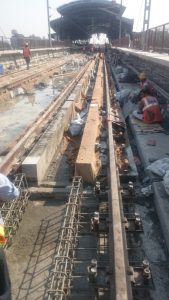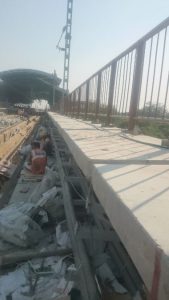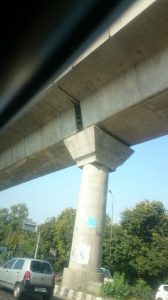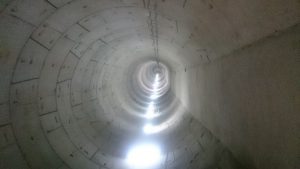08 Dec. 2015
Research Report Yuya Nishigaki (UTokyo)
| ・affiliation | :Department of Civil Engineering, the University of Tokyo |
|---|
| ・duration | :October 26th-December 6th, 2015 |
|---|
| ・program | :Research Internship 2015 |
|---|
Report of Delhi Metro Rail Cooperation
- Information
The construction of Delhi Metro is now in the phase 3. In the phase1, 65km metro line was constructed and 108km metro line was constructed in the phase2. In the phase3, the construction of 106km line is planned. The most of the tracks of Delhi metro are the standard gauges. The main reason for it is that they can use the standards of the other countries easily, reduce the weight of the coaches, and reduce the cost a little. If they use the broad gauge, the trains can go to the Indian railway’s track directly. However, so many problems will occur. The routine maintenance is very important for the subway because it is very difficult to reconstruct or repair the subway.
- Construction site of viaducts

Figure1
I went to the construction site of the viaducts. Figure1 is the picture of the station which is under construction. The station except the roof is made of concrete and the roof and its supports are made of metal. The design of the station, especially the roof was so good. The roofs of the Japanese stations look very cheap. So I think it have to be replaced for 21 century. About inside of the station, it is characteristic to paint the color directly to the wall in comparison of the Japanese station. And, I thought the concourse of the every station is bigger than Japanese one. It is because security check space is needed in the Indian station.



Figure2 Figure3 Figure4
Figure2 is the picture of the construction site of track. The point I noticed was that thorough curing was conducted by using some curing material. Another point was that the rails for preventing derailment were made of concrete. Japanese ones are made of metal. I think the reason why there is the deference is that about Japan, the rails for preventing derailment were not considered when the design was determined. And in case of ballast track, it is a little difficult to apply concrete rails for preventing derailment. Figure3 is the picture of the side wall of the viaduct. The characteristic point of this is that there is space on which people can walk very safely. In Japan there is no space like this on the viaduct. If this space doesn’t exist, people have to walk on the track when an accident happens. The track condition is not good for walking. I thought this space was very good. Figure4 is the picture of the viaduct which was taken from the below side of the viaduct. The post-tensioning method was applied to these new viaducts. On the other hand, it was not applied to the viaducts of Yellow line, which is constructed in Phase1. The concrete parts of the superstructure were made in the factory, transported from the factory to the construction site, assembled in the construction site and post-tensioning method were finally applied to the assembled concrete parts. About quality of the concrete, I could recognize the joints of the concrete when I got closer to the concrete walls. I thought the construction site of the viaduct was relatively clean but the garbage should be collected properly for escaping accidents and keeping the good working environment.
- Construction site of tunnels


Figure5 Figure6
I went to the construction of the tunnels. Figure5 is the picture of the construction site of the underground station and the tunnels. The excavation was almost finished. At the time of the excavation, they made the soil wall first which was hardened by using cement milk, the supports of the soil walls like struts were equipped, and the excavation was conducted. The number of the supports were relatively less than that of the construction site of Gaikan Expressway in Tokyo. It is because the soil of the bay area in Tokyo is softer than that of this construction site. The measures for safety was better than I expected. The fences for preventing people from falling down were installed. In comparison with the Japanese construction site, there are very few sign for inform someone of the danger. However, in comparison with the site in Vietnam, I could feel relax because of the measures for safety. Figure6 is the picture of the tunnel which is made by the TBM method. This is the method that tunnel boring machine excavates ground first, after that, the concrete members are assembled, and concrete rings are made. Because this concrete members are made in the factory, the quality of the members were excellent. And the accuracy of the tunnel was also good. Each member was bond to the soil by the ground anchor. They have the parts the shape of which is like a key in its edge and each member was bonded by these parts. Though the site tours, I was impressed to the quality of the viaducts and tunnels especially precast members. And I amazed at the hugeness of the station. In Japan I felt there are few big stations. It is because of the space for construction. I was happy to experience of the hugeness of the Indian infrastructures.

